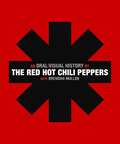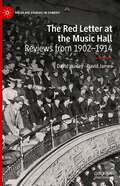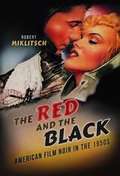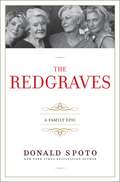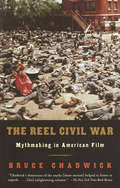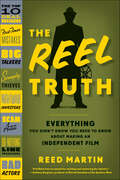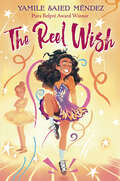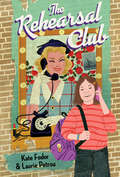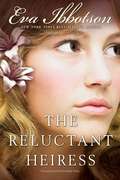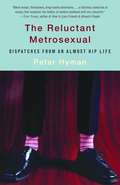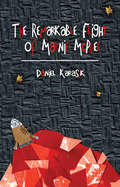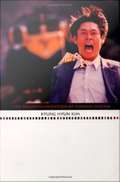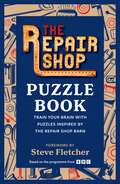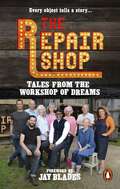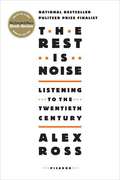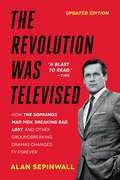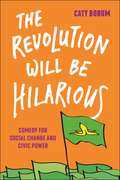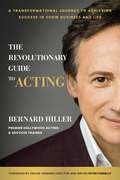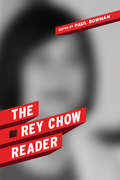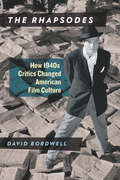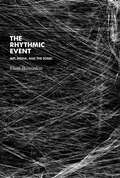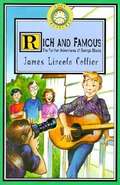- Table View
- List View
The Red Hot Chili Peppers: An Oral/Visual History
by The ChiliThe Red Hot Chili Peppers is the iconic band's audacious look back at their thirty-year odyssey—in their own words and accompanied by more than 300 spectacular photos and ephemera. Intimate, breathtaking, and outrageous, this is the essence of the Red Hot Chili Peppers."I am struck with the moments of these photos, the feelings of the times they were taken, and where we were at on our beautiful and happy-sad journey. It's pretty fucking heavy, actually, like thinking how much we have changed over the years, and all the different dynamics of our lives that shaped us, and also realizing so clearly that nothing has changed at all—we're all still just trying to get it on, make something great."It is all here, nothing can hide: all the honesty, the pretense, the courage and one-of-a-kind-ness, the unbridled joy, the melancholy, and the shields we put up to shelter our scared, vulnerable little selves."—Flea
The Red Letter at the Music Hall: Reviews from 1902–1914 (Palgrave Studies in Comedy)
by David James David HuxleyThis book reprints and analyses reviews of music hall acts from the family magazine The Red Letter, which was published by the Scottish based firm D C Thomson from 1899 to 1987. The articles under review range in date from 1902 to 1914, covering theatres all over Britain and acts from around the world. The reviews are uniquely detailed and shed light not only on the early acts of comics who would later go on to achieve wider fame, such as Will Hay and Robb Wilton, but also reveal the acts of long forgotten performers. These so-called ‘wines and spirits’ acts—acts that would never top the bill but who nevertheless toured the halls, sometimes for years on end, such as female impersonator Albert Letine, comedy magician Chris van Bern and female stand up Anna Dorothy amongst many others—deserve to be remembered every bit as much as the top of the bill acts. The articles are arranged in sections, covering race, gender, character comedy, physical comedy, male comedy and specialty or ‘spesh’ acts. The reviews reveal not only the contents of the acts but also the audience reactions to those acts and prevailing contemporary Edwardian attitudes. The articles are accompanied by their original illustrations, some of which are unique and, like the articles themselves, unseen for over a century.
The Red and the Black: American Film Noir in the 1950s
by Robert MiklitschCritical wisdom has it that we said a long goodbye to film noir in the 1950s. Robert Miklitsch begs to differ. Pursuing leads down the back streets and alleyways of cultural history, The Red and the Black proposes that the received rise-and-fall narrative about the genre radically undervalues the formal and thematic complexity of '50s noir and the dynamic segue it effected between the spectacular expressionism of '40s noir and early, modernist neo-noir. Mixing scholarship with a fan's devotion to the crooked roads of critique, Miklitsch autopsies marquee films like D.O.A., Niagara, and Kiss Me Deadly plus a number of lesser-known classics. Throughout, he addresses the social and technological factors that dealt deuce after deuce to the genre--its celebrated style threatened by new media and technologies such as TV and 3-D, color and widescreen, its born losers replaced like zombies by All-American heroes, the nation rocked by the red menace and nightmares of nuclear annihilation. But against all odds, the author argues, inventive filmmakers continued to make formally daring and socially compelling pictures that remain surprisingly, startlingly alive. Cutting-edge and entertaining, The Red and the Black reconsiders a lost period in the history of American movies.
The Red and the Blacklist: The Intimate Memoir of a Hollywood Expatriate
by Norma BarzmanThe horrors of the McCarthy era.
The Redgraves: A Family Epic
by Donald SpotoThe dramatic, poignant and revealing saga of the Redgraves, one of history's greatest families of actors. For more than a century, the Redgraves have defined theater and film while captivating the public eye. Their history is a rich tapestry of singularly talented individuals whose influence is felt to this day, yet their story has never before been told. In The Redgraves, bestselling biographer Donald Spoto draws on his close personal relationships with the family and includes both his interviews and unprecedented personal access to them. The result is a groundbreaking account of this extraordinary clan and their circle, including such luminaries as Elizabeth Taylor, Katharine Hepburn, and Sir Laurence Olivier. The story began in 1907 with the marriage of actress Daisy Scudamore to matinee idol Roy Redgrave and the birth in 1908 of their son, Michael, who became a famous stage actor and movie star. Michael's family and wild social circle knew that for decades he was insistently bisexual, notwithstanding his marriage to Rachel Kempson, one of England's most glamorous and admired actresses. Their daughter Vanessa, a great and revered performer, is the only British actress ever to win Oscar, Emmy, Tony, Cannes, Golden Globe, and Screen Actors Guild Awards--achievements that have been paralleled by a profound humanitarian commitment even as she tackled difficult and controversial roles. Vanessa's sister, Lynn Redgrave, led a triumphant and complex life in her own way, too. From her performance in the movie Georgy Girl to her prizewinning play about her father and her Oscar-nominated performance in Gods and Monsters, Lynn established herself as a very different Redgrave. Corin Redgrave, their brother, was known for his acclaimed performances onstage and screen--and he was a tireless and outspoken political radical. The family tradition of distinction continues with the careers of Joely Richardson and Jemma Redgrave and reached a high point in the life and career of Vanessa's daughter, Natasha Richardson, who earned a Tony Award for her role as Sally Bowles in the revival of Cabaret. Natasha's sudden death after a skiing lesson in 2009 shocked and saddened admirers of her work and graceful spirit. The product of more than thirty years of research, The Redgraves recounts the epic saga of a family that has extended the possibilities for actors on stage, screen, and television in Britain, America, and around the world.
The Reel Civil War: Mythmaking in American Film
by Bruce ChadwickArguing that film consistently distorts and sanitizes the past, Chadwick (history and film, Rutgers U.) details the distortions and myths purveyed by film from the KKK to the 1993 film in which actor Richard Gere plays a former slave-owner who is miraculously transformed into a populist who heroically drives off the KKK from a racially integrated community. For the bulk of film's history, myths have portrayed a myth of the underdog Southerner and demeaned African Americans, but new "politically correct," yet still sanitized, versions have begun to crop up in Hollywood productions. In the end, Chadwick seems to believe, despite changes in the treatment of the Civil war on screen, the "reel" still fails to be "real." Annotation c. Book News, Inc., Portland, OR (booknews.com)
The Reel Truth: Everything You Didn't Know You Need to Know About Making an Independent Film
by Reed MartinDid you know that most of the biggest indie filmmakers, screenwriters, and producers working today each made the same avoidable mistakes early on in their careers?The Reel Truth details the pitfalls, snares, and roadblocks that aspiring filmmakers encounter. Reed Martin interviewed more than one hundred luminaries from the independent film world to discuss the near misses that almost derailed their first and second films and identify the close shaves that could have cut their careers short. Other books may tell you the best way to make your independent film or online short, but no other book describes so candidly how to spot and avoid such issues and obstacles as equipment problems, shooting-day snafus, postproduction myths, theatrical distribution deal breakers, and dozens of other commonly made missteps, including the top fifty mistakes every filmmaker makes.From personal experience and his years as a freelance reporter covering independent film for USA Today and Filmmaker magazine, Martin uncovers the truth about the risks and potential rewards that go with chasing celluloid glory. Whether you're writing a screenplay, looking for financing, about to start shooting, or thinking about investing time and money (or someone else's money) in an independent film, The Reel Truth is a must-read.
The Reel Wish
by Yamile Saied MéndezAfter a panic attack prevents Florencia from performing as Clara in The Nutcracker and her best friend takes the lead, a new dance style helps her face her anxiety as well as a troubled friendship.Ballet is Florencia del Lago's entire world. After years of hard work, she is chosen as Clara in the winter production of The Nutcracker. Not only is she the youngest dancer to receive such an honor but also the first Latina. She's on track to be recruited by the best ballet companies.Unfortunately, she suffers a panic attack on opening night--on stage, in front of everyone. And then Selena, Florencia's best friend, steps right into the role to replace her. Just like that, Florencia's whole world falls apart--the ballet studio expels her, and her best friend turns on her, tormenting her on social media and in real life.But even though the one thing she was driven toward has come to an end, therapy and family support help Florencia open up to new experiences. She notices people at school she's never paid attention to before, and she even stumbles upon an Irish dance school and decides to give it a try. Can a new passion for Irish dance help Florencia find the joy of performing on the stage that she lost that fateful winter night?
The Rehearsal Club
by Kate Fodor Laurie PetrouA mystery spans decades at the Rehearsal Club in this story of sisterhood, friendship and following your dreams under marquee lights. Twelve-year-old Pal Gallagher is a newly minted New Yorker who loves to make people laugh and is hoping to find kindred spirits in her new city. Her older sister, Naomi, lives at the Rehearsal Club, a historic boarding house for aspiring actresses. Pal quickly gets swept up in the glamor and high-stakes of the theater world, and is drawn into a decades-old mystery about Posy, a boarder who was kicked out of the Club for reasons unknown. In 1954, Olive feels like she is working harder than anyone to make it to Broadway — along with the forty-four other young women who live at the Rehearsal Club. In comparison, her carefree friend Posy is making it look easy. Tensions rise when the two audition for the same part, kicking off a series of events that lead to Posy’s departure. What really happened all those years ago? The truth involves a Broadway play called The Weekend House, a necklace and a secret that Olive has kept all these years — until Pal and her new friends start digging into the past. What they learn could change the very fate of the Rehearsal Club itself. Key Text Features chapters dialogue author’s note Correlates to the Common Core States Standards in English Language Arts: CCSS.ELA-LITERACY.RL.5.3 Compare and contrast two or more characters, settings, or events in a story or drama, drawing on specific details in the text (e.g., how characters interact). CCSS.ELA-LITERACY.RL.6.3 Describe how a particular story's or drama's plot unfolds in a series of episodes as well as how the characters respond or change as the plot moves toward a resolution. CCSS.ELA-LITERACY.RL.6.6 Explain how an author develops the point of view of the narrator or speaker in a text.
The Reluctant Heiress
by Eva IbbotsonIn 1920s Austria, no one in the Viennese opera company knows that their wardrobe mistress Tessa is really a princess. But when the dashing self-made millionaire Guy Farne arrives at the opera, Tessa realizes that there may be more to life -- and love -- than just music.
The Reluctant Metrosexual
by Peter HymanThis collection of Peter Hyman's musings, more pop cultural than philosophical, range from the heartfelt to the absurd, whether he's describing the scotch-soaked grief of a bad breakup or his unfortunate decision to undergo a Brazilian bikini wax.
The Remarkable Flight of Marnie McPhee
by Daniel KarasikConvinced she is not like the rest of her boring family, nine-year-old Marnie McPhee decides it's time to leave Earth and take her place among the stars. But as she builds her spaceship, she realizes that maybe Earth isn't so bad after all, even if it is filled with imperfect human families. The Remarkable Flight of Marnie McPhee is a charming story of the infinite reaches of the imagination and the pleasure of dreaming.
The Remasculinization of Korean Cinema
by Kyung Hyun KimIn one of the first English-language studies of Korean cinema to date, Kyung Hyun Kim shows how the New Korean Cinema of the past quarter century has used the trope of masculinity to mirror the profound sociopolitical changes in the country. Since 1980, South Korea has transformed from an insular, authoritarian culture into a democratic and cosmopolitan society. The transition has fueled anxiety about male identity, and amid this tension, empowerment has been imagined as remasculinization. Kim argues that the brutality and violence ubiquitous in many Korean films is symptomatic of Korea's on-going quest for modernity and a post-authoritarian identity. Kim offers in-depth examinations of more than a dozen of the most representative films produced in Korea since 1980. In the process, he draws on the theories of Jacques Lacan, Slavoj Zizek, Gilles Deleuze, Rey Chow, and Kaja Silverman to follow the historical trajectory of screen representations of Korean men from self-loathing beings who desire to be controlled to subjects who are not only self-sufficient but also capable of destroying others. He discusses a range of movies from art-house films including To the Starry Island (1993) and The Day a Pig Fell into the Well (1996) to higher-grossing, popular films like Whale Hunting (1984) and Shiri (1999). He considers the work of several Korean auteurs--Park Kwang-su, Jang Sun-woo, and Hong Sang-su. Kim argues that Korean cinema must begin to imagine gender relations that defy the contradictions of sexual repression in order to move beyond such binary struggles as those between the traditional and the modern, or the traumatic and the post-traumatic.
The Repair Shop Puzzle Book: Train your brain with puzzles inspired by the Repair Shop barn
by The Repair ShopThe first puzzle book based on the BAFTA-award-winning television show The Repair Shop, with a foreword from The Repair Shop clocks expert Steve Fletcher.Think you know about the Repair Shop, its crafts, craftspeople and stories? Looking for fun brainteasers, word games and quizzes to train your brain and hone your problem solving skills? It's time to put your knowledge to the test with this collection of questions and puzzles designed to challenge and entertain.Blending together basic trivia, complex wordplay and a range of visual teasers, the book calls on the knowledge of Repair Shop fans to provide hours of challenges inspired by the iconic barn and the work that goes on inside. From silversmithing and woodworking, to teddy bears, clocks and paintings, the puzzles draw on the wide range of skills and objects that the Repair Shop team are famed for.With difficulty levels varying from pleasantly tricky to fiendishly hard, The Repair Shop Puzzle Book will delight all fans of the show.
The Repair Shop Puzzle Book: Train your brain with puzzles inspired by the Repair Shop barn
by The Repair ShopThe first puzzle book based on the BAFTA-award-winning television show The Repair Shop, with a foreword from The Repair Shop clocks expert Steve Fletcher.Think you know about the Repair Shop, its crafts, craftspeople and stories? Looking for fun brainteasers, word games and quizzes to train your brain and hone your problem solving skills? It's time to put your knowledge to the test with this collection of questions and puzzles designed to challenge and entertain.Blending together basic trivia, complex wordplay and a range of visual teasers, the book calls on the knowledge of Repair Shop fans to provide hours of challenges inspired by the iconic barn and the work that goes on inside. From silversmithing and woodworking, to teddy bears, clocks and paintings, the puzzles draw on the wide range of skills and objects that the Repair Shop team are famed for.With difficulty levels varying from pleasantly tricky to fiendishly hard, The Repair Shop Puzzle Book will delight all fans of the show.
The Repair Shop: Tales from the Workshop of Dreams
by Karen FarringtonWe all have treasures hidden away in the attic, well-loved and well-worn belongings that have been passed down from generation to generation. They may be damaged or no longer working, but we can't bear to part with them. The expert craftspeople of hit BBC series The Repair Shop are dedicated to restoring and conserving these heirlooms. They know that the true worth of these possessions doesn't lie in their monetary value, but in the memories they hold and the stories they tell.In this fascinating book, you'll step inside The Repair Shop's Workshop of Dreams to explore some of the most moving family stories from the hit BBC series. From a glamorous sequinned dress that belonged to a popular travelling circus performer to a pump organ that was brought from Jamaica by a member of the Windrush generation, each family item is brought vividly to life - and lovingly restored by the team of Repair Shop experts who also contribute to these expanded stories. With a foreword by Jay Blades, Tales from the Workshop of Dreams is a heartfelt love letter to our collective past, and a fascinating slice of social history.This book features items fixed by Repair Shop experts Steve Fletcher, Will Kirk, Lucia Scalisi, Suzie Fletcher, Kirsten Ramsay, Dominic Chinea, Brenton West, Tim Gunn, Sara Dennis, Chris Shaw, Matt Nickels, Amanda Middleditch and Julie Tatchell. With great care and attention to detail, the Repair Shop team resurrect priceless pieces of family history and breathe new life into the stories they hold.
The Rest Is Noise: Listening to the Twentieth Century
by Alexander RossRoss (music critic for The New Yorker) tells the story of 20th century classical composition, which for him is an "untamed art, and unassimilated underground." While composers from Richard Strauss to John Adams lie at the heart of the narrative, Ross also places them within a social and political world, describing the politicians, dictators, corporate officers, art patrons, intellectuals, and critics who have attempted to adjudicate and control musical expression and the social upheavals that impacted the lives of composers and the music they produced. He also goes beyond the genre confines of classical to discuss connections to such artists as Duke Ellington, Miles Davis, the Beatles, and the Velvet Underground.
The Revolution Was Televised: The Cops, Crooks, Slingers, and Slayers Who Change
by Alan SepinwallA phenomenal account, newly updated, of how twelve innovative television dramas transformed the medium and the culture at large, featuring Sepinwall's take on the finales of Mad Men and Breaking Bad.In The Revolution Was Televised, celebrated TV critic Alan Sepinwall chronicles the remarkable transformation of the small screen over the past fifteen years. Focusing on twelve innovative television dramas that changed the medium and the culture at large forever, including The Sopranos, Oz, The Wire, Deadwood, The Shield, Lost, Buffy the Vampire Slayer, 24, Battlestar Galactica, Friday Night Lights, Mad Men, and Breaking Bad, Sepinwall weaves his trademark incisive criticism with highly entertaining reporting about the real-life characters and conflicts behind the scenes. Drawing on interviews with writers David Chase, David Simon, David Milch, Joel Surnow and Howard Gordon, Damon Lindelof and Carlton Cuse, and Vince Gilligan, among others, along with the network executives responsible for green-lighting these groundbreaking shows, The Revolution Was Televised is the story of a new golden age in TV, one that's as rich with drama and thrills as the very shows themselves.
The Revolution Will Be Hilarious: Comedy for Social Change and Civic Power (Postmillennial Pop #29)
by Caty BorumAn insider’s look at the power of comedy to effect social changeFrom Trevor Noah’s The Daily Show and Hasan Minhaj’s Patriot Act, to Issa Rae’s Insecure and Corey Ryan Forrester’s Twitter feed, today’s multi-platform comedy refuses to shy away from the social issues that define our time.As more comedians lean into social justice activism, they help reshape the entertainment industry and offer creative, dynamic avenues for social change. The Revolution Will Be Hilarious offers a compelling insider’s look at how comedy and social justice activists are working together in a revolutionary media moment. Caty Borum invites readers into an expanding, enterprising arena of participatory culture and politics through in-depth interviews with comedians, social justice leaders, and Hollywood players. Their insights shed light on questions such as: What role does comedy play in helping communities engage the public with challenging social issues? How do social justice organizations and comedians co-create entertaining comedy designed to build the civic power of marginalized groups? And how are entertainment industry leaders working with social justice organizations to launch new comedy as both entertainment and inspiration for social change?Through this exploration, Borum argues that building creative power is crucial for marginalized groups to build civic power. The Revolution Will Be Hilarious positions the rise of social justice comedy as creative, disruptive storytelling that hilariously invites us to agitate the status quo and re-imagine social realities to come closer to the promise of equity and justice in America.
The Revolutionary Guide to Acting: A Transformational Journey to Achieving Success in Show Business and Life
by Bernard HillerBecome the actor you must be to turn your dreams into reality. For over 25 years, Bernard Hiller&’s revolutionary techniques and exercises have produced unprecedented success for actors, artists, and performers all around the world. Acting is always evolving, and in The Revolutionary Guide to Acting Bernard shares the latest methods to help you gain vital skills for success in this competitive industry. Set yourself apart at your next audition by using Bernard&’s unique techniques, and uncover the secrets to delivering unforgettable performances. Acting is a journey to self-awareness that will lead you to discover your true authenticity, empowering you to become unstoppable in show business. Cultivate the tools you will need for a long-lasting career and, ultimately, a more accomplished and happier life.
The Rey Chow Reader
by Rey ChowRey Chow is arguably one of the most prominent intellectuals working in the humanities today. Characteristically confronting both entrenched and emergent issues in the interlocking fields of literature, film and visual studies, sexuality and gender, postcolonialism, ethnicity, and cross-cultural politics, her works produce surprising connections among divergent topics at the same time as they compel us to think through the ethical and political ramifications of our academic, epistemic, and cultural practices. This anthology - the first to collect key moments in Chow's engaging thought - provides readers with an ideal introduction to some of her most forceful theoretical explorations. Organized into two sections, each of which begins with a brief statement designed to establish linkages among various discursive fields through Chow's writings, the anthology also contains an extensive Editor's Introduction, which situates Chow's work in the context of contemporary critical debates. For all those pursuing transnational cultural theory and cultural studies, this book is an essential resource.
The Rhapsodes: How 1940s Critics Changed American Film Culture
by David BordwellPauline Kael, Andrew Sarris, and Roger Ebert were three of America's most revered and widely read film critics, more famous than many of the movies they wrote about. But their remarkable contributions to the burgeoning American film criticism of the 1960s and beyond were deeply influenced by four earlier critics: Otis Ferguson, James Agee, Manny Farber, and Parker Tyler. Throughout the 1930s and '40s, Ferguson, Agee, Farber, and Tyler scrutinized what was on the screen with an intensity not previously seen in popular reviewing. Although largely ignored by the arts media of the day, they honed the sort of serious discussion of films that would be made popular decades later by Kael, Sarris, Ebert and their contemporaries. With The Rhapsodes, renowned film scholar and critic David Bordwell--an heir to both those legacies--restores to a wider audience the work of Ferguson, Agee, Farber, and Tyler, critics he calls the "Rhapsodes" for the passionate and deliberately offbeat nature of their vernacular prose. Each broke with prevailing currents in criticism in order to find new ways to talk about the popular films that contemporaries often saw at best as trivial, at worst as a betrayal of art. Ferguson saw in Hollywood an engaging, adroit mode of popular storytelling. Agee sought in cinema the lyrical epiphanies found in romantic poetry. Farber, trained as a painter, brought a pictorial intelligence to bear on film. A surrealist, Tyler treated classic Hollywood as a collective hallucination that invited both audience and critic to find moments of subversive pleasure. With his customary clarity and brio, Bordwell takes readers through the relevant cultural and critical landscape and considers the critics' writing styles, their conceptions of films, and their quarrels. He concludes by examining the profound impact of Ferguson, Agee, Farber, and Tyler on later generations of film writers. The Rhapsodes allows readers to rediscover these remarkable critics who broke with convention to capture what they found moving, artful, or disappointing in classic Hollywood cinema and explores their robust--and continuing--influence.
The Rhythm of Images: Cinema beyond Measure (Cultural Critique Books)
by Domietta TorlascoA rigorous and imaginative inquiry into rhythm&’s vital importance for film and the moving imageFocusing attention on a concept much neglected in the study of film, The Rhythm of Images opens new possibilities for thinking about expanded perception and idiosyncratic modes of being. Author Domietta Torlasco engages with both philosophy and cinema to elaborate a notion of rhythm in its pre-Socratic sense as a &“manner of flowing&”—a fugitive mode that privileges contingency and calls up the forgotten fluidity of forms. In asking what it would mean to take this rhythm as an ontological force in its own right, she creatively draws on thinkers such as Giorgio Agamben, Roland Barthes, Gilles Deleuze, and Luce Irigaray. Rhythm emerges here as a form that eludes measure, a key to redefining the relation between the aesthetic and the political, and thus a pivotal means of resistance to power.Working with constellations of films and videos by international artists—from Michelangelo Antonioni, Jean-Luc Godard, and David Lynch to Harun Farocki and Victor Burgin, among others—Torlasco brings to bear on them her distinctive concept of rhythm with respect to four interrelated domains: life, labor, memory, and medium. With innovative readings of artworks and critical texts alike, The Rhythm of Images fashions a vibrant, provocative theory of rhythm as the excess or potential of perception. Ultimately, the book reconceives the relation between rhythm and the world-making power of images. The result is a vision of cinema as a hybrid medium endowed with the capacity not only to reinvent corporeal boundaries but also to find new ways of living together.
The Rhythmic Event
by Eleni IkoniadouAn investigation into the affective modes of perception, temporality, and experience enabled by experimental new media sonic art.
The Rich and Famous: The Further Adventures of George Stable
by James Lincoln CollierAfter being discovered during a six-second spot on television, George Stable is now being groomed into the hot new singing sensation, "The Boy Next Door." Unfortunately, his dad has other plans for him for the summer, so George must weave a wacky web of deception - that might just get him killed! - in order to get his music career off the ground.
